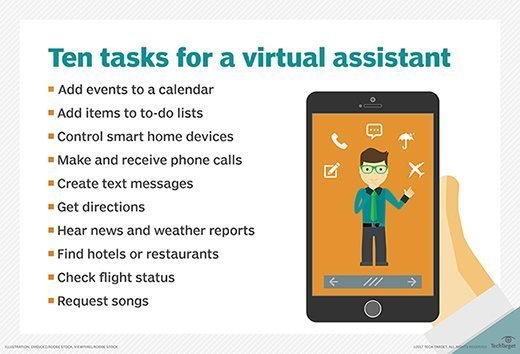
phonlamaiphoto - stock.adobe.com
Enterprise and home find use for intelligent virtual assistants
Intelligent virtual assistants have the capacity to augment employees, as well as improve convenience in homes, but only time will see their limitations resolved.
In this socially distanced and remote working age, organizations and private users alike are turning to virtual assistants powered by AI to make their lives easier.
As the offerings and benefits from virtual assistants continue to grow, so too will their ability to provide increasing amounts of value. However, not only are voice assistants finding their way into our daily lives, but AI-enabled personal assistants of all sorts are stepping in to help.
Virtual assistants can be deployed to assist with customer support systems and augment repetitive tasks to ease employee stress and continue to improve their capabilities. Despite this, public concerns over third-party data gathering and struggles to generate realistic conversations continue to hold them back.
Intelligent assistants providing augmented intelligence capabilities
These AI-enabled conversational agents can quickly identify the customer and help answer a variety of questions. If the customer needs to be transferred to a human agent, the intelligent assistant can be used in an augmented manner to help the customer service representative better identify customer issues while on the phone.
This kind of personal assistant artificial intelligence has upside for companies wanting to improve their customer support systems. Unlike human agents who can only handle a handful of conversations at a time, chatbots can be easily scaled to manage thousands of discussions without hindering the speed or accuracy of responses.

Intelligent assistants have also become more common in the workplace, as they have the ability to act as augmentative resources for organizations. Rather than having an employee handle repetitive tasks, companies have turned to AI-enabled assistants that are available around the clock to assist with their organizational needs. This can include setting virtual reminders and assisting with scheduling, conference calls and note taking.
Companies are also using voice assistants to enable employees to connect with internal departments, such as HR or IT, to facilitate internal support. With a few simple interactions with a virtual assistant, employees can reset passwords, manage support ticket requests and submit vacation or time-off requests with ease. In this way, artificial intelligence is being used in an augmented fashion, freeing up the HR or IT team to work on higher-value tasks.
Intelligent assistants making their way into our daily lives
Intelligent personal assistants have made their most indelible impact in our mobile devices. These virtual assistants include the likes of Siri, Google Assistant and Alexa and help make appointments, search for various information and compose text messages. With a few simple voice commands, users are able to interact with their assistant to get the help they need.
Virtual assistant devices have seen widespread adoption. This field has spread to include a diverse collection of devices that are providing increasing value. Amazon's Alexa device has only been around for six years but has already sold hundreds of millions of units.
Users are interacting with these intelligent personal assistants for a variety of basic tasks. These include answering questions, helping with conversational commerce, playing music, adjusting lights and thermostats and performing personal or business assistant capabilities.
Intelligent voice assistants are making their way into dorm rooms at some colleges, helping students with a variety of campus-related needs such as hours of operation for the bookstore or library, directions on campus and course times.
The future of intelligent assistants
While voice and conversational assistants of all sorts are finding their way into work and the home, there are numerous shortcomings and concerns with their use. Virtual assistants are challenged by the current inability of many artificial intelligence systems to handle domain knowledge and their lack of common sense and machine reasoning. Subtle context or slang can be missed by speech recognition and phrases can be misinterpreted.
Virtual assistants also lack the ability to have a natural two-way conversation. When users have simple queries, these assistants' voice recognition capabilities rarely struggle. However, if users are looking to have multiturn conversations, the process can become tedious and the assistant will struggle to communicate in a natural way. While some companies are trying to work on this, the technology is still a way off from reaching this level.
The lack of voice authentication is also a significant concern, especially when dealing with personal information. For personal use, users don't want just anyone to be able to access their bank information or purchase products through the device without any approval or oversight. From an enterprise standpoint, without the ability to know for certain who is requesting a specific skill or capability, it becomes difficult to grant access or control access levels to sensitive information. Authentication issues are real shortcomings of these devices that need to be addressed.
Furthermore, in a recent survey by Voicebot.ai, over 33% of survey respondents report that they are hesitant to purchase or use a voice assistant or chatbot due to concerns over privacy and security. Many are concerned that these voice assistants are inappropriately recording and sharing their conversations with third parties.
They are also concerned with how the data shared with these devices is being used by the platform companies, as well as advertisers and other third parties. These concerns could become a major roadblock to greater widespread adoption of AI-enabled assistants, if not adequately and suitably addressed.
However, it's clear that regardless of concerns, intelligent assistants are being increasingly used and continue to get more intelligent over time. While there is still room for improvement, with continued use, training and adoption, these devices may soon deliver the benefits promised of artificial intelligence.







